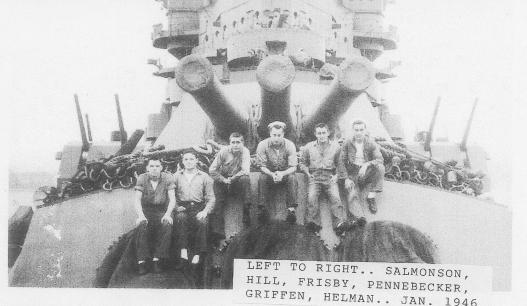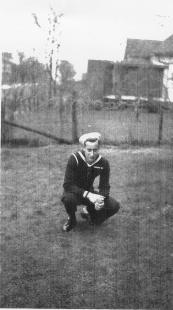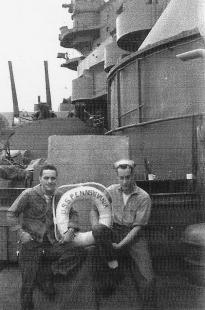Donald Eugene Pennebecker
Era: World War II
Military Branch: Navy




Photo 1: Donald Pennebecker Photo 2: Aboard the USS Pennsylvania, left to right: Salmonson, Hill, Frisby, Pennebecker, Griffen, Helman, January 1946. Photo 3: Mr. Pennebecker Photo 4: On the USS Pennsylvania. Mr. Pennebecker is at right.
Donald Eugene Pennebecker served in World War II in the Pacific Theater.
He served in the U.S. Navy. He was drafted on April 2, 1943, and discharged on February 11, 1946.
Mr. Pennebecker went to boot camp at Great Lakes Naval Base. He was assigned to the 7th Division and served aboard the battleship USS Pennsylvania (BB-38). His unit left Bremerton, Washington, in August 1943. His job was to load a 40mm quad (U.S. 40mm Bofors anti-aircraft gun) at a battle station.
The Pennsylvania engaged in battles as far north as the Aleutian Islands, Alaska, to the South China Sea, south of Australia. In the South Pacific, the Pennsylvania’s job was to shell the beaches before the amphibious forces landed.
His rank was Seaman 1st Class.
He was decorated with the: Navy Commendation Ribbon, American Theater War Ribbon, Asiatic-Pacific Ribbon, Philippine Liberation Ribbon, and six combat stars.
Mr. Pennebecker was born in 1924 in Marathon County, Wisconsin, the son of Benjamin and Effie Pennebecker. He graduated from Mellen High School in 1942.
Source: Veterans’ Memorial Hall veteran history form; veteran’s relative’s account (below); unidentified, undated Wisconsin newspaper article (below)
Donald crossed the equator on his birthday. There wasn’t the usual celebration, though, because they were under attack.
During the Philippine Liberation campaign, he saw General Douglas MacArthur go to shore at Leyte Gulf, where he got his feet wet, stepped on shore, and said, “I will return.” He then went back to his ship, the USS Minneapolis.
During the war, they bombarded Guam often. The Japanese would invade in-between so the ship would go back out to sea to hide for a couple of weeks.
The chaplain announced to pause for a moment of prayer because they had heard the Japanese task force was coming. There were 100,000 troops on shore, and 100,000 in the transports to be unloaded. It was the Navy’s job to protect the troops. The Japanese had previously lost about 95% of their navy in the Battle of Leyte Gulf and Surigao Straits. About 100 kamikazis (Japanese suicide planes) came at the ship continuously, so the Navy started firing at them. Donald remembers this every time the American national anthem is played, “bombs bursting in air.”
Their ship was torpedoed on August 12, 1945, three days before the unconditional surrender on August 15, 1945, at Buckner Bay in Okinawa. Possibly Tokyo Rose had gotten wind that the big shots were on board. The admirals and generals were then transferred to another ship. They lost about nineteen lives and, without a big hole in the ship, they were without power, dead in the water. They were taking on water fast. After temporary repairs, they were towed by tugboats toward Guam.
Amidst a terrible typhoon, the captain kept coming on the loudspeaker to remind them to continue to pray and thus make preparations to possibly abandon ship. Lord willing, they weathered the storm and arrived at Guam on September 6.
After temporary repairs, they left Guam on October 4. Moving at 9 knots per hour, they arrived at Puget Sound Navy Yard on October 24. Needless to say, about 1,000 Army personnel who opted for a ride back to the States, who were being discharged, were none too happy to be riding with the Navy sailors at a snail’s pace.
The USS Pennsylvania was awarded the Navy Commendation ribbon by the Secretary of the Navy, James Forrestal. All crewmembers are entitled to wear this special ribbon.
“Pennebecker Had a Rough Time During Philippine Invasion”
by Dottie Evans
While aboard a battle wagon for 22 months, Don Pennebecker, 22, nephew of Bruno Poppe, Mellen, who is now on leave, admits he had to rough it now and then, when participating in the invasions of Leyte Island and Lingayen Gulf on Luzon.
“We had a pretty closed call last fall while our ship was anchored off the coast of Leyte,” Don stated bluntly. “About 122 Zeros popped out of the blue and let go with some heavy bombing. Those Japs don’t rate high when it comes to getting their shots, though, because the wasn’t much damage received, at least not much that I know of,” he stated.
“Another time at Leyte, we really had to do some slugging. Three fleets surrounded the island and let those dirty little demons have what they deserve,” he continued. “Living through one of those bombings, is like coming through a hideous nightmare, only it isn’t as easy to forget.”
According to Don, a fleet is composed of large numbers of battle wagons, cruiser destroyers, and PT boats and when all start to fire away, nothing could out bet the noise and excitement of it.
While overseas, Don was in the Aleutians, Gilbert Islands, Marianas Island, West Carolines, Palau and Leyte Gulf.
A graduate of Mellen high school in the class of ’42, Don was employed at the Penokee Veneer company until entering the navy April 2, 1943. He received his boot training at Great Lakes, Ill.

